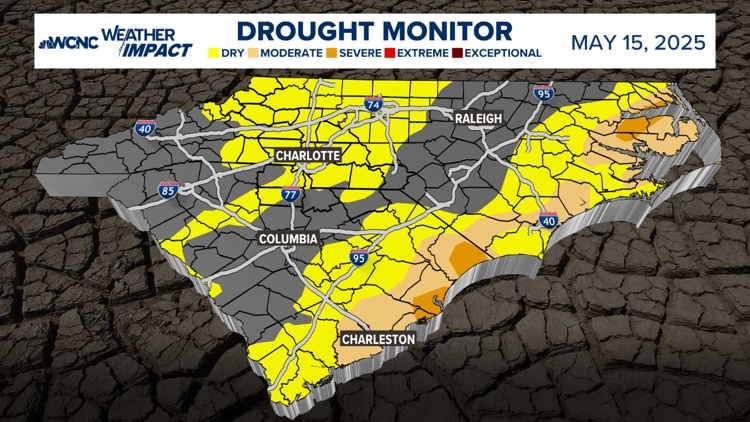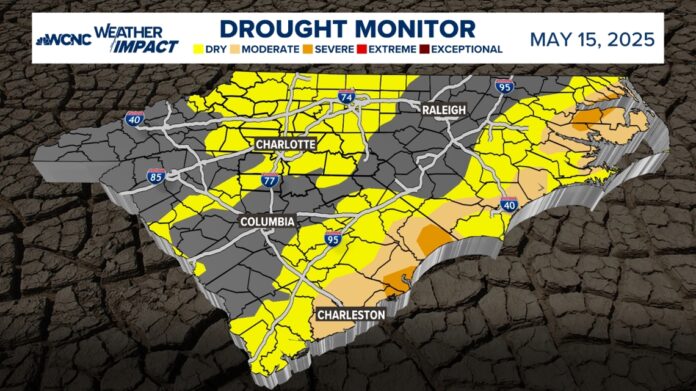
North Carolina saw significant drought relief with 39.10% of the state now drought-free. Many are now free from abnormally dry status as well.
CHARLOTTE, N.C. — After months of dry conditions and months of an official drought, North Carolina is finally getting some relief thanks to prolonged rain in the last week.
The latest update from the U.S. Drought Monitor on May 15 shows a remarkable turnaround in drought status across both North Carolina and South Carolina, thanks to recent rainfall and seasonal changes.
📊 Key North Carolina statistics – then vs. now
Here’s how conditions have improved in just one week:
-
“No Drought” Areas (None):
-
Now: 39.10%
-
Last Week: 26.30%
-
📈 +12.8% improvement
-
-
Abnormally Dry to Exceptional Drought (D0–D4):
-
Moderate to Exceptional Drought (D1–D4):
-
Now: 12.59%
-
Last Week: 45.88%
-
📉 -33.3% decrease
-
-
Severe Drought (D2):
-
Now: 1.31%
-
Last Week: 6.67%
-
📉 -5.36% improvement
-
📉 Drought Decline Over Time
📊 Key South Carolina statistics – then vs. now
Data as of May 13, 2025 | Compared to May 6, 2025
“No Drought” Areas (None):
-
Now: 49.23%
-
Last Week: 12.92%
-
📈 +36.31% improvement
Abnormally Dry to Exceptional Drought (D0–D4):
Moderate to Exceptional Drought (D1–D4):
-
Now: 15.19%
-
Last Week: 49.60%
-
📉 -34.41% decrease
-
Now: 2.99%
-
Last Week: 9.17%
-
📉 -6.18% improvement
📉 Drought Decline Over Time
Three Months Ago (Feb 13)
🌱 What this means on the ground
Improvement in drought conditions is more than just numbers — it translates to real-world relief:
-
Lawns are greening back up.
-
Crop stress and irrigation demands are easing.
-
Hay production and pasture health are beginning to recover.
-
Voluntary water restrictions are being lifted in some areas.
-
The risk for wildfires is dropping to near-normal levels.
🐄 A Look Back: Drought impacts at their worst
Earlier in the year, farmers reported feeding hay early, reduced crop yields, and stress to wildlife. In D2 zones, water use restrictions and closed recreational sites became more common. Fortunately, those impacts are now rapidly receding.
💧 Looking ahead
While this week’s report is encouraging, state and local officials remind residents that drought recovery is a process. Soil moisture, stream flows and reservoir levels can lag behind atmospheric improvements. Continued rainfall and water conservation will be key to long-term recovery.
Contact Chris Mulcahy at cmulcahy@wcnc.com and follow him on Facebook, X, Instagram and TikTok.



